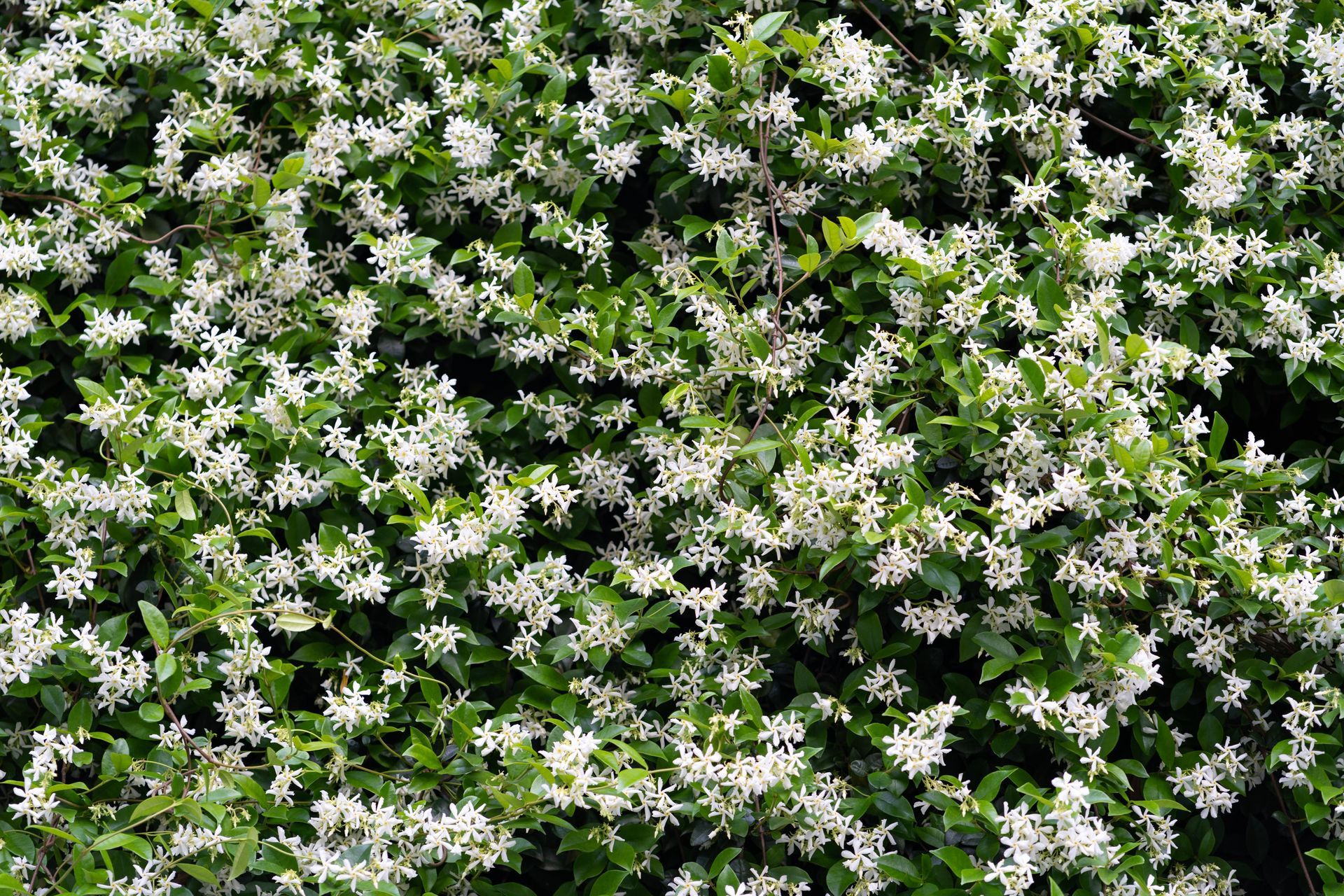Jasmine Tree: The Ultimate Plant Care Guide

True jasmine trees have tendril-free climbing branches. They have yellow or white tubular flowers with a pinwheel shape and multiple lobes. In rare cases, the flowers are also pink. Some double-flowered varieties of jasmine have also been developed. Here's a detailed guide on jasmine tree care.
Fast Facts for the Jasmine Tree
| Common Name | Jasmine, Common Jasmine |
|---|---|
| Scientific Name | Jasminum officinale |
| Harvest | N/A |
| Light | Six hours of full sunlight every day and two to four hours of partial shade per day |
| Water | Weekly watering is required unless the soil is too dry |
| Soil | Require moderately fertile, sandy, and moist soil |
| Fertilizer | Require 3 pounds of nitrogen fertilizer per 1,000 square feet; a fertilizer with an NPK ratio of 10-10-10 is ideal |
| Pests | Susceptible to mites, scale, and whiteflies |
| Diseases | Prone to being damaged by Fusarium wilt, rust, and blight |
| Growing Zone | 7 to 10 |
Table of Contents
Everything You Need to Know to Take Care of A Jasmine Tree
Jasmine flowers are known globally due to their dainty and delicate nature. While most jasmine flowers are white, some varieties also produce cream or yellow blooms. It's possible to grow jasmine in a hanging basket or pot. Here's what you need to know about growing a jasmine tree.
Planting
When choosing the right jasmine plants for your garden, consider their hardiness, spread, and height. When you plant jasmine trees, need to keep a few things in mind to make sure the tree grows beautiful fragrant flowers.
You should plant a jasmine tree between June and November. Most jasmine species prefer full sun and some partial shade. However, if you choose a summer-flowering variety, plant it in a sunny spot. For all other jasmine species, select a shaded area.
Where
Most growers plant jasmine trees near a fence or a wall since jasmine can grow as a tendril. Alternatively, you can grow jasmine in a pot. Either way, be ready to enjoy the beauty of a jasmine flower.
How
Dig a hole and fill it with compost or well-rotted manure at the bottom. If the soil is too heavy, add grit to improve drainage.
To grow as a tendril, the jasmine plant will need some sort of support, such as an angled cane or a fence. If you're using a cane, make sure it's pointed in the direction where you want the jasmine to grow.
Care and Maintenance
Jasmine trees are easy to grow since they don't have many diseases or pest issues. Growing jasmine indoors makes them more prone to red spider mites, mealybugs, and other greenhouse pests. If you're careful, you should have beautiful fragrant white flowers in no time. Here's how to care for jasmine plants.
Sun and Temperature
How much sun a jasmine plant needs will depend on its species. Most jasmine trees need nearly six hours of direct sunlight and two hours of partial shade daily. Plant your jasmine accordingly.
A jasmine plant can thrive in a temperature range between 60 to 75 degrees Fahrenheit. After it has bloomed, you can keep your jasmine plant pot in a cool room, but it should not have a temperature higher than 41 degrees.
Water and Humidity
Like other in-ground flowering shrubs, jasmines also do not need a lot of water. You should water your tree once every week. You can use drip irrigation for trees if you want. If the temperature is exceptionally high, water more frequently. The soil shouldn't be moist at all times. Instead, let it dry for a few days before watering again.
A jasmine tree growing in a container should be watered multiple times per week, especially if it's hot. If you're not careful, you may overwater Jasmine.
Overwatered jasmine trees may have black spots on their leaves. If you see these, skip watering your plant for a few days to prevent root rot.
Soil
Wild jasmine can grow pretty much anywhere. Home-grown jasmine trees will do well in sandy, loamy, and well-drained soil with moderate fertility. Jasmines prefers soil with a pH range of anywhere from 6.5 to 7.5.
If your soil is low on fertility, you can improve it with amendments like compost, peat moss, and organic matter.
Fertilizing
On average, a jasmine tree requires 3 pounds of nitrogen every 1,000 square feet. Get a fertilizer with a 10-10-10 NPK ratio, as it will have 10% of nitrogen, potassium, and phosphorus each.
Start fertilizing your jasmine tree when you see the signs of first growth before the flower buds form. Or, you can fertilize following the last frost. When it's growing season, fertilize your tree every month or six weeks.
Pruning
The best time to prune jasmine trees is after flowering, which is at the end of summer. Pruning the jasmine shrub at this time gives it enough time to grow.
There's not a lot you have to do in this regard. Simply prune the flowered stems back to a lower side shoot that's strong enough to bear the weight of the flowers.
Also, prune weak, thin, damaged, or crossing stems. Some species, such as star jasmine, grow quite quickly and need regular pruning.
Propagation
There are two ways to propagate jasmine; seeds or cuttings. Both methods help you create beautiful jasmine plants.
Seeds
As mentioned, the right time to plant jasmine is somewhat around June. Start with the seeds at least three months beforehand.
Put the seeds in water for 24 hours before you plant them. Fill small pots or six to eight-pack cells with your preferred potting soil. Soak the soil. Let it drain before you plant seeds.
Plant one seed per cell. Cover these cells or pots with plastic for moisture retention, and put them outside in direct sunlight.
Make sure the soil is moist until the seedlings sprout. When the seeds have grown at least two true leaf pairs, repot them into a large 3.7-liter planter.
The planters should be kept inside for 30 days of initial growth. After that, you may put them outside. Alternatively, you can let jasmine grow as an indoor plant for the first year. Transplant the plant into the soil in the second year of growth.
Cuttings
Get stem cuttings from your jasmine plant by selecting a healthy stem and cutting it at an angle. The cuttings should be 6 inches in length and cut below a leaf:
- Remove the leaves at the bottom of the cutting.
- Dip your cutting in rooting hormone powder.
- Fill a planter with damp sand and put one cutting in it.
- Keep this planter in a plastic bag in a 75-degree Fahrenheit place for moisture retention.
The roots will develop in about 30 days. After that, you can transplant the cuttings into a large pot.
Did You Know? In some cultures, people use jasmine flowers to flavor baked goods, puddings, frozen desserts, and drinks.
Common Issues With Jasmine Trees
Even though it's not that hard to grow jasmine, there are a few problems that can stunt the tree's growth or make it not flower. Here are some of them.
Growing Problems
If your jasmine tree is not flowering but is producing enough vegetative growth, it's likely that you are overfertilizing it. Giving a plant too much nitrogen uses extra nutrition to make leaves and stems rather than flowers. You can resolve this by reducing the amount of fertilizer or choosing a fertilizer with a lower nitrogen ratio than the one you're using.
Jasmine may also experience some deficiencies, such as iron deficiency. Iron-deficient plants will experience yellowing foliage and stunted growth. You can supplement your plant with ferrous sulfate at monthly intervals.
Pests
Plant pests are usually of two types; sucking insects and foliage insects. Sucking insects suck on the plant to eat its sap and other material. Meanwhile, foliage insects mainly cause visual damage to the plant. Here are some pests of the jasmine tree.
Spider Mites
Spider mites are small insects that feed on the leaves of the jasmine tree. They have the following symptoms:
- White or yellow spots on the leaves
- Silky web formation around the leaves or stems
- Bronze patches spots in some parts of the tree
The best way to get rid of spider mites is to cut the stems where they are prevalent. You can also spray them with a fast jet of water or use a miticide.
Mealy Bugs
Mealybugs are sap-sucking insects coated with white wax. Their presence on jasmine trees gives the plant a cotton-like appearance.
Many gardeners use a strong stream of water to remove them, but this does not always work. You can also use a neem oil solution or insecticidal soap to get rid of mealybugs.
Scales
If your tree is attacked by a small number of scales, the insects will not cause extensive damage. But a large attack can damage or kill your plant.
Cut the section of the vining jasmine or potted plant affected by scale. Some horticultural oils can also help remove scales.
Diseases
Common jasmine trees are also susceptible to certain diseases. Some of them are discussed below.
Southern Blight
Some species, such as angel wing jasmine, yellow jasmine, and Arabian jasmine, are also prone to southern blight. The most common symptoms of this disease are wilted leaves and yellowing foliage.
Prevention is better than cure when it comes to southern blight. For this, sanitize your pruning tools before switching from one part of the plant to another. If your plant is badly affected by southern blight, remove it completely.
Powdery Mildew
Powdery mildew is a common plant disease that attacks new stems and growth in spring. It can also affect shoots, leaves, flowers, and buds.
Some symptoms of powdery mildew are:
- White patches on the lower side of the leaves
- Curling of leaf edges
- Reddish-purple blotches
- Black fungal structures on the leaves
You can consult an arborist to find the right fungicide for powdery mildew treatment. The fungicide should contain potassium bicarbonate and/or sulfur.
Rust
Rust is another fungal disease that affects the jasmine flower along with its stem and leaves. The common symptoms of rust are yellow spots on the underside of the leaf, along with brown or black bumps on the upper side. Remove the affected parts of the plant before the infection spreads to other parts.
Sweet New Earth's Final Word On Jasmine Trees
Jasmine trees or plants are among the most beautiful front yard trees in your landscape. White or pink, the Jasmine has some of the most beautiful foliage of all plants and we simply can't get enough of them.
FAQs

Christina Hernandez
Christina has done most of her research on environmental science but recently has changed her focus towards sustainable forestry. She has a passion for the outdoors and wants to spread that passion to the world.
Join our community!
Join to receive guides, insights, and the latest gardening deals!
